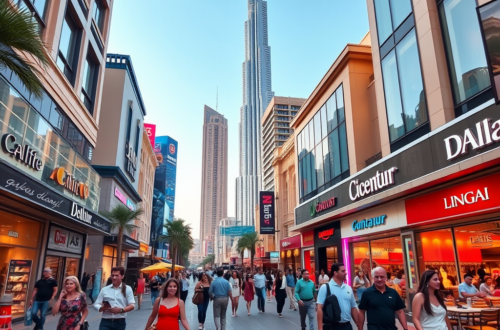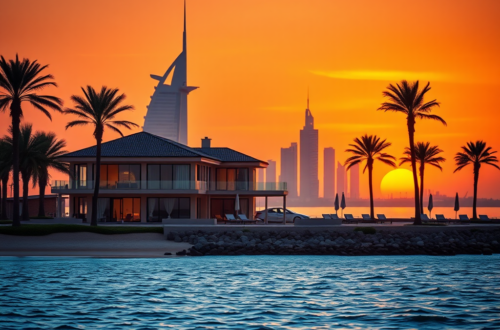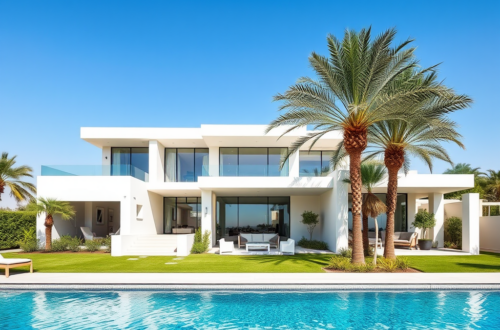
Dubai has continually transformed itself into a global hub, merging state-of-the-art modernity with a rich cultural backdrop. At the heart of this remarkable evolution are mixed-use developments, which are forging a new path for urban living. These multi-functional spaces not only provide residential areas but also integrate shopping centers, leisure activities, and workspaces, effectively redefining how people interact with their environment. As the city grows, so does the demand for these innovative developments that cater to diverse lifestyles and preferences. The impact of mixed-use designs has been profound, prompting communities to prosper as they provide more than just a place to live. They create vibrant, interconnected neighborhoods that encapsulate the essence of urban life in Dubai.
In this article, we will delve into the evolution of mixed-use developments in Dubai, exploring their benefits, iconic examples, and the factors driving their increasing popularity. We will also discuss the future of these innovative spaces in the context of technology and sustainability. As we navigate the urban landscape of Dubai, it becomes evident why these mixed-use developments are not just a trend, but a fundamental shift in how urban living is conceptualized.
The Evolution of Mixed-Use Developments in Dubai
The journey of urban development in Dubai has been nothing short of extraordinary. From a modest fishing village to a bustling metropolis, the transformation has involved key changes in urban planning and architecture. The incorporation of mixed-use spaces began to gain traction towards the late 20th century, influenced heavily by rapid population growth and evolving consumer needs. Traditional zoning concepts, which segregated residential, commercial, and recreational areas, became less appealing as people desired more integrated living experiences.
Key projects such as Dubai Marina and the Burj Khalifa complex have played pivotal roles in this shift, showcasing the viable integration of diverse functionalities within a single vicinity. These developments exemplify how mixed-use designs foster community interaction and accessibility while also promoting convenience. As urban dynamics progressed, stakeholders recognized the immense potential of mixed-use projects in enhancing Dubai’s skyline and lifestyle. The city embraced this change, paving the way for a variety of iconic mixed-use developments that cater to both locals and tourists.
Benefits of Mixed-Use Developments
The advantages of mixed-use developments are manifold, significantly enriching urban living in Dubai. One of the most notable benefits is the enhancement of lifestyle options for both residents and visitors. These spaces facilitate a seamless blend of work, leisure, and living, enabling individuals to engage with their community while enjoying a myriad of amenities at their doorstep. The convenience of having businesses, residential units, and recreational facilities within close proximity has proven to be a game-changer for city dwellers.
- Integration of diverse spaces that foster social interactions.
- Reduction in the need for long commutes, thus promoting sustainability.
- Economic stimulus through job creation and business opportunities.
Moreover, the economic impact of mixed-use developments extends beyond individual projects. They serve as catalysts for local communities by attracting investment, tourists, and new residents. This influx not only boosts the economy but also enhances the cultural vibrancy of neighborhoods, making them more attractive for living and working. An effective mixed-use space operates on the principles of efficiency and functionality, setting a precedent for future urban developments in Dubai.
Health and Wellbeing Advantages
One of the often-overlooked benefits of mixed-use developments is their contribution to health and wellbeing. Access to amenities and services that promote a healthier lifestyle is a crucial aspect of these integrated spaces. In essence, the integration of parks, gyms, and health services right where people live significantly encourages physical activity and social interaction. This is essential in a fast-paced city like Dubai, where busy schedules can often hinder personal wellness.
Additionally, the inclusion of green spaces in urban environments is paramount. Numerous studies have evidenced the positive impact of nature on mental health, making it imperative for developments to incorporate greenery:
- Reduces stress and anxiety levels.
- Improves air quality and promotes biodiversity.
- Creates spaces for community gatherings and activities.
| Aspect | Impact on Residents |
|---|---|
| Convenience | Access to essentials without traveling far. |
| Community | Foster relationships and community bonding. |
| Sustainability | Reducing carbon footprint through mixed functions. |
Iconic Examples of Mixed-Use Developments
Diving into the heart of Dubai’s architectural innovations reveals a multitude of mixed-use developments that have emerged as landmarks. Projects like Dubai Creek Harbour, City Walk, and Jumeirah Lake Towers exemplify how these spaces can redefine urban living. Each development is unique, featuring distinctive amenities that cater to varying demographics and lifestyles.
- Dubai Creek Harbour: A vibrant waterfront community with residential areas, retail, and entertainment, framed by stunning views of the skyline.
- City Walk: A modern lifestyle destination combining shopping, dining, and leisure, designed to be pedestrian-friendly.
- Jumeirah Lake Towers: A striking development featuring high-rise towers with residential, commercial, and recreational facilities seamlessly coexisting.
These iconic developments not only reflect the latest architectural trends but also highlight Dubai’s commitment to fostering integrated urban environments. They embody the essence of convenience, community, and contemporary living, drawing both residents and visitors to their vibrant spaces.
Factors Driving Popularity
Several factors have fueled the popularity of mixed-use developments in Dubai, shaping the discourse around urban living. A significant driver of interest stems from the shifting consumer preferences over recent years. As more individuals prioritize flexibility and convenience, the integrated nature of these developments aligns perfectly with modern lifestyles.
The backdrop of economic growth and rapid urbanization has furthermore contributed to this increasing demand. Dubai’s strategic location and robust infrastructure make it an appealing destination for both local and expatriate communities. Furthermore, government initiatives fostering economic diversification and supporting real estate development are essential in encouraging investments in mixed-use projects. These steps create a conducive environment for innovation and community-building.
The Role of Technology and Sustainability
The rise of technology and sustainability has become an integral part of Dubai’s mixed-use development narrative. Many projects are now adopting smart city innovations, ensuring that residents benefit from integrated tech solutions. From smart parking to energy-efficient systems, such advancements not only enhance living standards but also contribute to environmental sustainability.
Emphasizing sustainable practices within mixed-use communities is vital as urban landscapes evolve. Developers are increasingly incorporating green building materials and eco-friendly designs. As the concept of sustainability permeates urban development, it is essential to implement measures that promote eco-conscious living:
- Water-saving technologies.
- Renewable energy solutions.
- Waste reduction initiatives.
The Future of Mixed-Use Developments in Dubai
As we glance towards the horizon, the future of mixed-use developments in Dubai appears promising. Emerging trends indicate a sustained enthusiasm for these spaces, particularly due to demographic shifts and evolving lifestyles. The city is likely to witness innovative designs that further cultivate a sense of community, resilience, and sustainability.
However, navigating challenges such as regulatory frameworks and market fluctuations will necessitate collaboration among developers, investors, and the government. Opportunities abound for enhancing urban living through thoughtful design and community engagement, ensuring that Dubai remains a leader in modern urbanism. The evolution of mixed-use development in Dubai is not just a response to demand; it is a reimagining of the urban landscape that prioritizes the quality of life for its residents.
Conclusion
The significance of mixed-use developments in Dubai is multifaceted, impacting lifestyle, community, and economy. Their growing popularity reflects a paradigm shift in urban living, where convenience and connectivity reign supreme. By embracing these innovative structures, Dubai is setting the stage for a vibrant, integrated future, appealing to the diverse needs of its residents.
As we continue to witness the evolution of these developments, it becomes clear that they represent more than just architectural feats. They signify the future of urban living—one that prioritizes unity, sustainability, and adaptation. In a city known for its audacious ambition, mixed-use developments will undoubtedly continue to play an essential role in shaping the landscape and experience of living in Dubai.
FAQ
- What are mixed-use developments?
- Mixed-use developments combine residential, commercial, and recreational spaces in one location, allowing for a more integrated lifestyle.
- Why are mixed-use developments gaining popularity in Dubai?
- The evolving demands of residents, urbanization, and preferences for convenience and community living drive their popularity.
- Can you name some iconic mixed-use developments in Dubai?
- Notable examples include Dubai Creek Harbour, City Walk, and Jumeirah Lake Towers, each offering unique amenities and experiences.
- How do mixed-use developments impact the economy?
- They create jobs, spur growth in local businesses, and attract both residents and tourists, positively influencing the local economy.
- What sustainability practices are commonly found in Dubai’s mixed-use developments?
- Many projects incorporate energy-efficient designs, green building materials, and eco-friendly public spaces, contributing to a sustainable urban environment.





